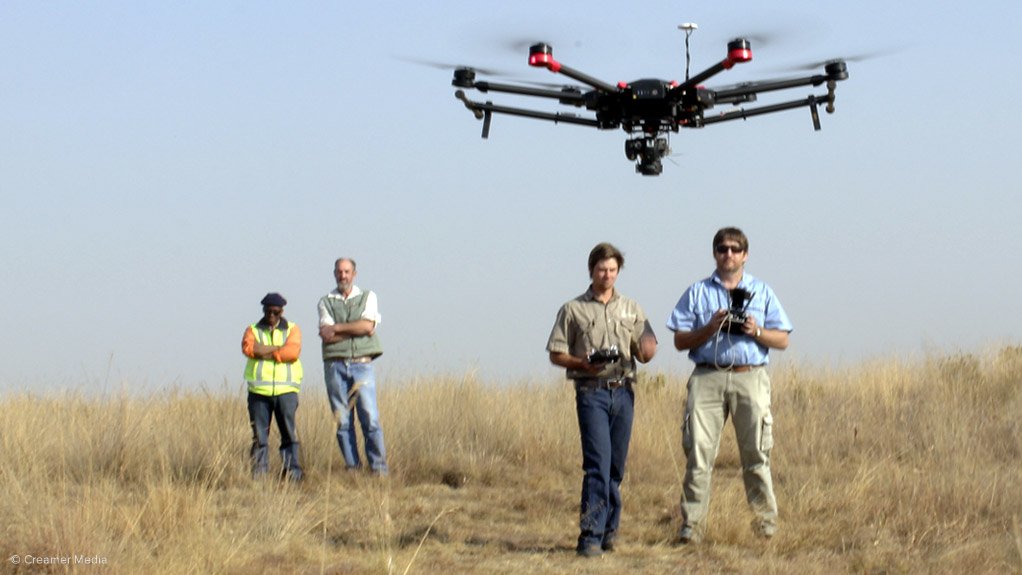South African mining industry must prepare for future



BETTER, FASTER Drones are successfully being used in the mining industry to reduce costs and save time through aiding the three-dimensional modelling and the analytics of orebodies
NEIL JACOBSOHN The Joburg Indaba offers the opportunity for sector managers to focus their attention away from the operational demands of day-to-day management and to think long term
It is critical that the South African mining sector works unceasingly to make government understand the need to remain competitive with global miners through upskilling people so that they are capable of functioning and prospering in a technologically advanced environment, says global business and technology network FutureWorld senior partner Neil Jacobsohn.
Jacobsohn will discuss the technological developments that are fundamentally disrupting the global mining sector’s approach and how to expand its potential in his keynote presentation on the radical future of mining at the 2017 Joburg Indaba mining conference.
He stresses that South Africa cannot afford to lose its competitive position as a world leader in deep-level mining by falling behind technologically advancing mines in more developed countries. The poor relationship between the South African government and the mining sector is a major stumbling block, says Jacobsohn, with the power of the unions – and their historically close relationship with government – creating additional strain on the competitiveness of the sector. Technology, he claims, is the only solution.
“Success belongs to those who actively make the decision to understand, design and create their own future. The future is not a matter of chance, but a matter of choice,” Jacobsohn advances.
Although this will be FutureWorld’s first year attending the Joburg Indaba, which will take place at the Inanda Club, in Sandton, Johannesburg, from October 4 to 5, he highlights that the company has worked extensively with most of the major mining houses in South Africa and several big international players to help them understand and prepare for the future of the industry.
“The Joburg Indaba offers the opportunity for sector managers to focus their attention away from the operational demands of day-to-day management and to think long term.”
The Future is Here
Jacobsohn adds that a timely response from mining companies to rapidly advancing disruptive technologies is essential, with the idea of a “connected mine” already a reality in many parts of the world, thanks to the exponentially expanding role of the Internet of Things (IoT), Big Data and advanced analytics. These tools enable mine managers to have a single digital view of operations, regardless of the different systems and technologies in place, allowing them to fine-tune production to market demands on a minute-by-minute basis and, simultaneously, significantly enhance safety levels through the mechanisation of dangerous processes. IoT implementation is increasingly being driven by low-cost, low-power wide area networks that enable miners to install devices, which communicate in real time, across their sites, above and below ground.
“It’s all part of a new world where speed and efficiency are critical success factors. It’s far better to know in advance when a bearing is about to burn out, for example, rather than to halt production after the incident.”
Multinational mining company BHP Billiton is, moreover, already using driverless vehicles to shift iron-ore in Australia – working 23 hours a day to dramatically increase productivity and competitiveness, while South African coal and heavy minerals mining company Exxaro is using drones to survey coal stocks, significantly improving processing time.
Jacobsohn adds that drones are also successfully being used to aid three-dimensional (3D) modelling and the analytics of orebodies – further reducing costs and saving time. He cites gold miner Goldcorp’s Eleonore mine, in Canada, as a prime example of where IoT is enabling managers to identify patterns from what were previously considered to be unrelated variables and, thereby, control output in real time. Feedback is, thus, instant, rather than after the fact.
“The connected mining marketplace is estimated to be worth around $10-billion by 2020 and the influence of this technology, of course, goes beyond just managing the mine. Because of their remote nature, many mines provide – or at least contribute to – local infrastructure development and new technologies make that much more effective and productive in terms of cost. For example, power is a major factor in mining and major advances in solar – including moveable solar plants – are changing that parameter.”
Jacobsohn highlights that 3D printing is another technology with great prospects in the mining industry, providing the potential for critical machine parts to be produced on site in remote locations, rather than having to wait for delivery. Demonstrating the reality of this possibility, he notes that astronauts on the International Space Station, for example, recently needed a particular wrench for maintenance and, rather than wait weeks for delivery by the next space shuttle, the US National Aeronautics and Space Administration simply emailed the Space Station the instructions to 3D print the wrench.
“Four-dimensional printing – a new technology to implant ‘intelligence’ into materials – is providing further disruption across industries. Under the right conditions, materials can self-form to make or change shape – think of the possibilities for water pipes that can shrink or swell in response to changing water flow, replacing the need for expensive pumps at mines.”
Highlighting the broad scope of technological innovation in mining, Jacobsohn further points out that biology is also playing a greater role in mining, both in terms of bioremediation of sites and using bacteria to extract minerals from the orebody, while BlockChain – the technology that underpins cryptocurrencies like Bitcoin and Ethereum – is providing a secure, encrypted distributed ledger system to streamline procurement and contracts, and to remove waste and corruption from the system. The role of space mining – mining asteroids for rich supplies of minerals and water – and deep-sea mining are also being rapidly explored, and are likely to become a reality within the next decade, Jacobsohn notes.
“Smart miners are also focusing on new minerals of the future, such as lithium, used to power electric cars. Other minerals like graphite, cobalt and titanium – used in powder form for 3D printing – are also experiencing increased demand, as are the rare-earth minerals needed to manufacture electronics. It’s time to stretch the minds of mining managers beyond the limits of ‘business as usual’ and the Joburg Indaba will provide an ideal platform for this,” he concludes.
Comments
Press Office
Announcements
What's On
Subscribe to improve your user experience...
Option 1 (equivalent of R125 a month):
Receive a weekly copy of Creamer Media's Engineering News & Mining Weekly magazine
(print copy for those in South Africa and e-magazine for those outside of South Africa)
Receive daily email newsletters
Access to full search results
Access archive of magazine back copies
Access to Projects in Progress
Access to ONE Research Report of your choice in PDF format
Option 2 (equivalent of R375 a month):
All benefits from Option 1
PLUS
Access to Creamer Media's Research Channel Africa for ALL Research Reports, in PDF format, on various industrial and mining sectors
including Electricity; Water; Energy Transition; Hydrogen; Roads, Rail and Ports; Coal; Gold; Platinum; Battery Metals; etc.
Already a subscriber?
Forgotten your password?
Receive weekly copy of Creamer Media's Engineering News & Mining Weekly magazine (print copy for those in South Africa and e-magazine for those outside of South Africa)
➕
Recieve daily email newsletters
➕
Access to full search results
➕
Access archive of magazine back copies
➕
Access to Projects in Progress
➕
Access to ONE Research Report of your choice in PDF format
RESEARCH CHANNEL AFRICA
R4500 (equivalent of R375 a month)
SUBSCRIBEAll benefits from Option 1
➕
Access to Creamer Media's Research Channel Africa for ALL Research Reports on various industrial and mining sectors, in PDF format, including on:
Electricity
➕
Water
➕
Energy Transition
➕
Hydrogen
➕
Roads, Rail and Ports
➕
Coal
➕
Gold
➕
Platinum
➕
Battery Metals
➕
etc.
Receive all benefits from Option 1 or Option 2 delivered to numerous people at your company
➕
Multiple User names and Passwords for simultaneous log-ins
➕
Intranet integration access to all in your organisation



















